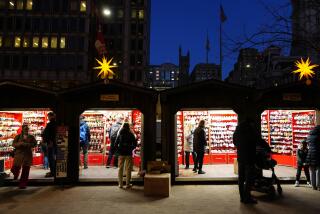‘94 Durable Goods Orders Up 13.9% in Biggest Leap Since ’78
- Share via
WASHINGTON — Factory orders for “big-ticket” durable goods such as cars and computers rose 1.4% in December, capping the biggest annual increase in 16 years.
But analysts noted that the strength at the end of the year came largely from military and transportation orders.
The Commerce Department said Thursday that December orders for durable goods--products expected to last three years or longer--totaled a seasonally adjusted $161.4 billion. It was the second straight advance, following a 3.2% gain to $159.1 billion in November. Orders had dropped 0.8% in October.
The December increase helped push orders for 1994 up 13.9%, the biggest advance since an 18.3% surge in 1978. Orders rose 8.6% in 1993.
“Overall, the report still shows strength in the manufacturing sector, but there are a few signs of softness emerging,” said Lynn Reaser, an economist at First Interstate Bancorp in Los Angeles.
These signs, she said, include a drop in retail sales during the December shopping season and a recent buildup of inventories at the wholesale level, which could mean fewer orders as businesses clear excess stocks from their shelves.
Still, Reaser is among the many economists who expect the Federal Reserve Board to boost short-term interest rates next week for the seventh time in a year to cool the economy further and keep inflation from boiling over.
Fed Chairman Alan Greenspan, testifying on Capitol Hill for the second straight day, said the buoyant economy is showing signs of “simmering down.”
“The very torrid rate of increase is slowing down,” Greenspan told the Senate Budget Committee. “It’s no longer flat-out. Fairly good moderate growth is occurring.”
In its report, the Commerce Department said military orders shot up 65% last month, led by large increases for ships and tanks. Excluding the military component, orders dropped 0.8%.
Reaser noted that military orders are often volatile and said that “the increase . . . is not going to be an ongoing factor” in durable-goods orders. Military orders had fallen 6.2% in November and 16.3% in October.
The orders for ships and tanks also helped drive the transportation sector up 5.4%. Without this sector, orders were up just 0.1%.
Other increases included primary metals, up 5.2%, and electronic and other electrical equipment, up 3%. But orders for industrial machinery and equipment were down 5%, the second decline in a row.
Reaser also noted that orders for non-defense capital goods excluding aircraft were down 0.4%, the second monthly decline. These orders are often a barometer of business plans to expand and modernize.
Unfilled orders rose 0.7%, the fourth consecutive advance. This backlog is often a measure of whether current facilities and manpower are able to keep up with demand. When it rises, it often suggests a need for larger production lines and more jobs.
In another report, the Labor Department said first-time claims for unemployment benefits fell by 13,000 last week to a seasonally adjusted 325,000, lowest since 321,000 during the week ended Dec. 24.
More to Read
Inside the business of entertainment
The Wide Shot brings you news, analysis and insights on everything from streaming wars to production — and what it all means for the future.
You may occasionally receive promotional content from the Los Angeles Times.









